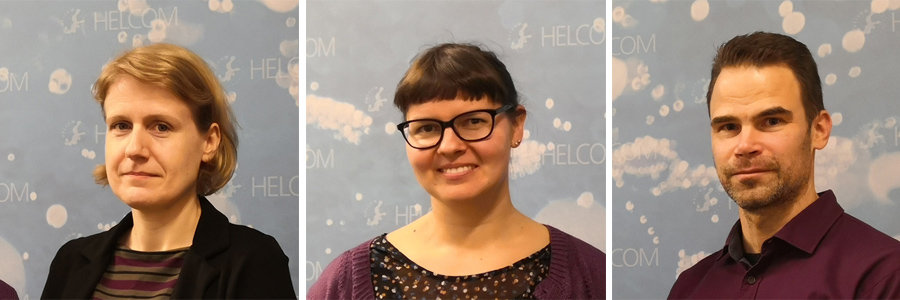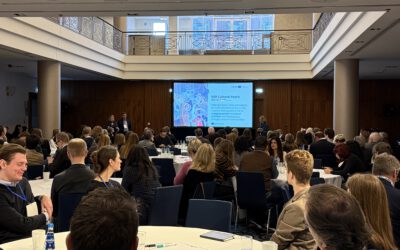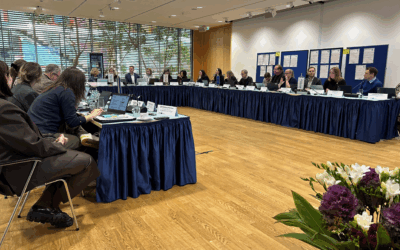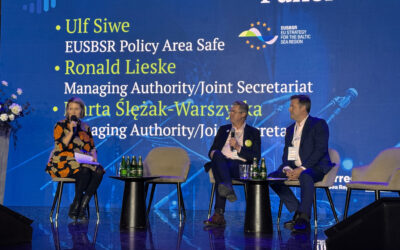SuMaNu is about sustainable manure and nutrient management and is directly connected with the ongoing development of a Nutrient Recycling Strategy for the Baltic Sea. Interreg Baltic Sea Region’s project platforms are designed to capitalise on the results of existing projects financed from different EU funding Programmes and to create synergies between them, e.g. by feeding into policy making. We interviewed three experts from the SuMaNu platform, which started in autumn 2018, to find out.

Minna Sarvi, Susanna Kaasinnen and Kaj Granholm working in the Interreg project platform SuMaNu. © IB.SH (Maack)
Minna Sarvi
Minna Sarvi is a researcher at the Natural Resources Institute Finland (Luke). Finland has voiced a strong political commitment to become a model country for nutrient recycling by 2030. Luke is an important player in pursuing this goal nationally and is also a strong international actor. Minna has done research with a focus on phosphorous recycling, e.g. the BONUS PROMISE project, and is managing the project platform SuMaNu, co-financed by Interreg Baltic Sea Region.
Susanne Kaasinen
Susanna Kaasinen, an environmental expert specialised in sustainable food production and circular economy, works as a project manager for SuMaNu at the Secretariat of HELCOM, the Baltic Marine Environment Protection Commission. HELCOM is an intergovernmental organisation founded of nine countries and the European Union. HELCOM participates in a number of Interreg projects.
Kaj Granholm
Kaj Granholm is an environmentalist who works for the Baltic Sea Action Group (BSAG), an independent non-profit foundation in Finland. BSAG works to restore the good ecological balance of the Baltic Sea and acts as a catalyst for multi-stakeholder cooperation. Kaj has a history of fifteen years of promoting sustainable agriculture practices among farmers, advisors and administration and worked, among others, in the Baltic Slurry Acidification project.
What is a Nutrient Recycling Strategy and why is HELCOM developing one right now?
Susanna Kaasinen: The aim of the strategy is to reduce the nutrient inputs to the Baltic Sea. This aim is ambitious and has been pursued for many years. Earlier approaches were based on a linear thinking, while now the approach is more circular. Some countries had already developed national nutrient recycling strategies, e.g. for agriculture in Finland and for waste water in Germany. From the individual countries, it was taken now to the international HELCOM level.
The HELCOM Nutrient Recycling Strategy focusses on two areas: manure and sewage. For each of those topics there is one project platform funded by Interreg Baltic Sea Region, SuMaNu and BSR Water. The HELCOM countries have agreed to draft the strategy by the end of the year 2020. So far we have agreed on a vision and objectives for the strategy. We hope that with this new approach to nutrient management, it will be easier to get all those working with nutrients committed because recycling nutrients in agriculture is a win for both the environment and the farmers.
What does it mean, a circular approach to nutrient management?
Minna Sarvi: Well, circular contrasts the linear approach of earlier times to reducing nutrient input to the Baltic Sea. The linear approach was about avoiding that nutrient from agriculture leak into the Baltic Sea, for example by reducing the amounts of fertiliser applied on the field. The circular thinking of today is about keeping the nutrients in agriculture by circulating them on one farm or between farms within one region. Circulating nutrients means: When manure is applied on the fields, nutrients are taken up by crops. If those crops are used as animal feed, part of the nutrients go back to manure and can be used again in crop production. Recycling nutrients in agriculture in this manner can help the farmers to save the money which they would have spent for mineral fertiliser.
What do the projects covered by the SuMaNu platform contribute to the development of the HELCOM Nutrient Recycling Strategy?
Kaj Granholm: The Interreg project Baltic Slurry Acidification looked into one specific technological measure to reduce the emissions of nitrogen in the chemical form of ammonia. Ammonia typically evaporates from slurry to the air and eventually ends up to the sea. Slurry acidification technologies reduce the amount of nitrogen that evaporates and also improve the fertilizing value of slurry. The project proved that the technologies works, but they require very specific approaches to each farming site and thus a lot of knowledge to find cost-effective ways of doing it. Farmers may often need specialised contractors for this. Stricter environmental legislation is one way to make this technology attractive to farmers, along with economic incentives. We provide this new information and latest research results on the effects of the slurry acidification technologies to be considered in the strategy.
Minna Sarvi: The BONUS PROMISE project funded by the BONUS Programme was about manure as fertiliser. BONUS PROMISE consolidated scientifically that manure is a good option for more sustainable farming because we found, e.g. that heavy metal concentrations in manure are commonly low, and that plants can take up phosphorous from manure as easily as from mineral fertiliser. In addition, it has been calculated for Finland that if we used all the phosphorous in manure to fertilise the crop fields, we would not need any mineral fertiliser in addition.
Kaj Granholm: The Interreg cross-border cooperation project Green Agri (CBC EE-LV)
is about best practices on the farm level, which includes the planning of fertilization and the storing and spreading of manure in the best way – environmentally, economically and technologically. The project showed something very important: We need to give the farmers some flexibility in choosing their methods for their specific conditions, which differ a lot between places, within the year and between years. In the regulations we need to provide a range of options available and be smart to allow for this flexibility. Information exchange, like demonstrations, trainings on the farm, experience exchange locally and internationally are important tools to bring best practices in use on farms.
How does the SuMaNu platform support the policy making process related to the HELCOM Nutrient Recycling Strategy?
Minna Sarvi: One of the activities in the platform is to develop policy recommendations. This is directly targeted at the strategy development. And while the strategy is drafted on HELCOM level it still involves nine countries and the EU, several observer organisations and other stakeholders. The SuMaNu platform helps to keep up direct communication and involve all of them.
To this end, we will carry out national events in each country within SuMaNu to get both feedback and country perspectives on our recommendations. In this way, the project platform helps to improve the stakeholder involvement, i.e. the development process of the Nutrient Recycling Strategy and hopefully in the end the chances of its effective implementation.
Interview: Stefanie Maack, Interreg Baltic Sea Region Managing Authority/Joint Secretariat.






